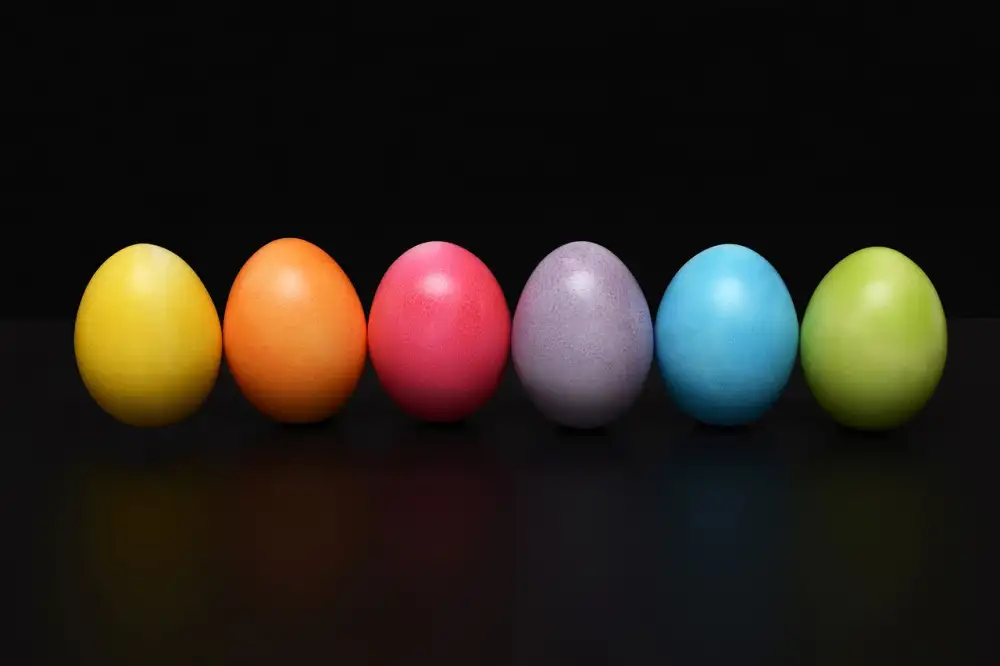Delight in the Flavors of Easter: Discover the Perfect Recipe for Traditional Easter Bread at Home

Easter is a time of joy and celebration, and one of the most beloved traditions during this holiday season is the baking and sharing of Easter bread. This delicious treat, also known as Pascha or Kulich in some cultures, holds a special place in the hearts and palates of people around the world.
Easter bread is a sweet, rich loaf that is often flavored with aromatic spices such as cinnamon, nutmeg, or cardamom. It is typically adorned with decorative toppings like colored sprinkles or candied fruit, making it a visually stunning centerpiece for any Easter table.
Whether you are continuing a long-standing family tradition or embarking on a new culinary adventure, making Easter bread at home allows you to connect with the spirit of the holiday and create lasting memories with loved ones. So gather your ingredients and let's dive into the fascinating world of Easter bread!
History and Significance of Easter Bread
Easter bread holds a rich history and deep significance in many cultures around the world. Its origins can be traced back to ancient times when bread was considered a sacred symbol of life and fertility. The tradition of baking special bread for Easter has been passed down through generations, symbolizing rebirth and new beginnings.
In Christian traditions, Easter bread is closely associated with the resurrection of Jesus Christ. It is believed that the round shape of the bread represents the crown of thorns worn by Jesus, while the eggs or other decorative elements symbolize new life and hope. Sharing Easter bread with family and friends is seen as a way to spread joy and celebrate the spirit of renewal during this holy season.
Different regions have their own unique variations of Easter bread, each with its own cultural significance. For example, in Greece, Tsoureki is a sweet braided bread flavored with orange zest and decorated with red-dyed eggs to symbolize Christ's blood. In Italy, Pane di Pasqua is often shaped like a dove or lamb, representing peace and sacrifice.
Easter bread continues to be cherished today as a meaningful culinary tradition that brings families together to celebrate Easter's spiritual significance.
Traditional Ingredients Used in Easter Bread
Traditional Easter bread is a delightful treat that is made using a variety of ingredients. The basic recipe typically includes flour, yeast, sugar, butter, eggs, milk, and salt. However, the specific ingredients can vary depending on regional and cultural traditions.
One common ingredient found in many Easter bread recipes is citrus zest. Lemon or orange zest adds a bright and refreshing flavor to the bread. Some recipes also call for the addition of dried fruits such as raisins or currants, which provide bursts of sweetness throughout the loaf.
Another key ingredient in Easter bread is spices. Cinnamon and nutmeg are commonly used to add warmth and depth to the flavor profile. These aromatic spices infuse the bread with a comforting scent that fills the kitchen as it bakes.
In some variations of Easter bread, anise seeds are added to give a subtle licorice-like flavor. These tiny seeds not only enhance the taste but also contribute to the overall aesthetic appeal of the loaf with their speckled appearance.
To make the bread extra special, many bakers incorporate decorative elements such as colored sprinkles or candied fruit on top. These vibrant additions not only make the bread visually appealing but also add an extra burst of sweetness and texture.
While these are some of the traditional ingredients used in Easter bread, it's important to note that there are countless regional variations across different cultures. Each variation brings its own unique combination of flavors and textures that make Easter bread a truly special treat enjoyed around the world.
Step-by-Step Recipe for Making Easter Bread
1. In a mixing bowl, combine 2 cups of flour, 1/4 cup of sugar, and 1 packet of active dry yeast.
2. In a saucepan, heat 1 cup of milk and 1/4 cup of butter until warm (about 110°F).
3. Gradually add the warm milk mixture to the dry ingredients while stirring.
4. Beat in 3 eggs, one at a time, until well incorporated.
5. Stir in an additional 2 cups of flour to form a soft dough.
6. Knead the dough on a lightly floured surface for about 5 minutes until smooth and elastic.
7. Place the dough in a greased bowl, cover with a clean cloth, and let it rise in a warm place for about 1 hour or until doubled in size.
8. Punch down the dough and divide it into three equal portions.
9. Roll each portion into a rope about 12 inches long and braid them together.
10. Place the braided bread on a greased baking sheet and cover it again to rise for another 30 minutes.
11. Preheat the oven to 350°F (175°C) while the bread is rising.
12. Brush the bread with an egg wash made by beating an egg with a tablespoon of water.
13. Bake for about 25-30 minutes or until golden brown and sounds hollow when tapped on the bottom.
14. Allow the bread to cool completely before serving.
Follow these simple steps to create your own delicious Easter bread at home!
Tips and Tricks for Perfect Easter Bread
1. Use fresh ingredients: To ensure the best flavor and texture, make sure to use fresh ingredients, especially yeast, flour, and eggs.
2. Activate the yeast properly: Yeast is a crucial ingredient in Easter bread. To activate it properly, dissolve it in warm water with a pinch of sugar before adding it to the dough.
3. Knead the dough thoroughly: Proper kneading helps develop gluten in the dough, resulting in a lighter and fluffier bread. Knead for at least 10-15 minutes until the dough becomes smooth and elastic.
4. Allow enough time for rising: Give the dough enough time to rise properly. This allows for better fermentation and enhances the flavor of the bread. Follow the recipe's instructions for rising times or until the dough has doubled in size.
5. Avoid overproofing: While proper rising is essential, be careful not to overproof the dough as it can lead to a dense and heavy bread. Keep an eye on it during proofing and proceed to bake when it has risen adequately.
6. Brush with egg wash: Before baking, brush your Easter bread with an egg wash mixture (beaten egg + milk) to give it a beautiful golden color and a glossy finish.
7. Add decorative touches: Enhance your Easter bread's appearance by adding decorative touches like braids, crosses, or sprinkling colored sugar on top before baking.
8. Bake at the right temperature: Preheat your oven to the recommended temperature stated in your recipe before placing your Easter bread inside. Baking at the correct temperature ensures even cooking and prevents under or over-baking.
Remember that practice makes perfect! Don't be discouraged if your first attempt isn't flawless; each batch will bring you closer to mastering this delightful Easter treat!
Variations and Regional Adaptations of Easter Bread
Just like any traditional dish, Easter bread has evolved and adapted to different regions and cultures around the world. Each country puts its own unique twist on this festive treat, resulting in a delightful array of flavors and shapes.
In Greece, they have Tsoureki, a sweet bread flavored with orange zest and often decorated with red-dyed eggs. Italy offers Colomba di Pasqua, a dove-shaped bread enriched with butter, candied fruits, and almonds. In Russia and Ukraine, Kulich is a tall cylindrical bread made with raisins, nuts, and sometimes even saffron.
Eastern European countries like Poland have their own version called Babka. It is typically baked in a bundt pan and flavored with rum-soaked raisins or dried fruits. In Germany, Osterzopf is popular – a braided bread made with yeast dough and often topped with powdered sugar.
Other variations include Paska in Ukraine, Cozonac in Romania, Pinca in Croatia, and Mazanec in Czech Republic. Each of these regional adaptations adds its own distinct flavors and traditions to the Easter table.
Whether it's the shape, ingredients used, or the method of preparation, these variations make Easter bread even more special. Trying different versions can be an exciting way to explore diverse culinary traditions while celebrating this joyous holiday.
No matter which variation you choose to make or enjoy during Easter festivities, one thing remains constant – the love and warmth that comes from sharing homemade bread with family and friends. So go ahead and experiment with different recipes to find your favorite version of this timeless Easter delight!
Serving and Enjoying Easter Bread
Once your homemade Easter bread is ready, it's time to serve and enjoy this delightful treat. Traditionally, Easter bread is served as a centerpiece during the Easter meal, symbolizing the resurrection of Christ. It can be enjoyed on its own or paired with butter, honey, or jam.
To enhance the experience, consider slicing the bread and toasting it lightly before serving. This will give it a slightly crispy texture while maintaining its softness inside. The warm aroma that fills the room will surely entice everyone around the table.
Easter bread also makes a wonderful addition to brunch or afternoon tea. Serve it alongside other traditional Easter dishes such as ham, eggs, and spring vegetables for a complete holiday feast. Its sweet flavor pairs well with savory dishes and adds a touch of elegance to any spread.
For an extra special touch, you can decorate your Easter bread with colored sprinkles or icing sugar before serving. This adds a festive and visually appealing element to the already beautiful loaf.
Remember to store any leftovers in an airtight container to keep them fresh for several days. If you find yourself with too much bread, consider sharing it with friends and family or donating it to local charities.
No matter how you choose to serve and enjoy your Easter bread, remember that this delicious treat is not only about satisfying your taste buds but also about celebrating the joyous occasion of Easter with loved ones.
In conclusion, there is no better way to celebrate Easter than by indulging in the delightful flavors of homemade Easter bread. This traditional treat not only brings a sense of joy and togetherness but also carries with it a rich history and significance.
By following the step-by-step recipe and incorporating the traditional ingredients, you can create a delicious loaf of Easter bread that will impress your family and friends. Remember to use high-quality ingredients and pay attention to the details, such as kneading the dough properly and allowing it to rise adequately.
While the recipe provided is a classic version, don't be afraid to experiment with variations and regional adaptations. Whether you add dried fruits, nuts, or spices, these personal touches can make your Easter bread even more special.
Once your bread is baked to perfection, serve it proudly at your Easter gathering. Whether enjoyed fresh out of the oven or toasted with butter, this homemade treat is sure to delight everyone's taste buds.
So this Easter, take some time to embrace tradition and create memories by making your own Easter bread. The process may require patience and effort, but the end result will be a delicious masterpiece that embodies the spirit of this joyous holiday. Happy baking!
Published: 25. 02. 2024
Category: Home



